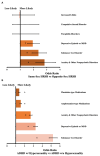H is for hypersexual: Sexuality in youths with ADHD
- PMID: 39817274
- PMCID: PMC11732009
- DOI: 10.3389/frcha.2022.1048732
H is for hypersexual: Sexuality in youths with ADHD
Abstract
Background: Recent research into the association between ADHD and hypersexuality has been extremely skewed toward male patients and contribute to stigma against individuals engaging in same sex sexual behaviors. We sought to expand research on this important relationship and to address these shortcomings.
Methods: Using data from the TriNetX database, we created two patient cohorts of patients 21 years or younger, separated by presence or absence of ADHD diagnosis. We analyzed disorders of sexual behavior, comorbid psychiatric illness, and medication type. Those with ADHD were subdivided into same-sex high risk sexual behavior (HRSB) and opposite-sex HRSB. The ADHD group was analyzed based on the presence or absence of any disorder of sexuality. The outcomes measured were disorders of sexual behavior, comorbid psychiatric illness, and medication type.
Results: In a study of 1,355,184 analyzed patient records, patients ADHD were more likely to have all measured outcomes. Orientation of HRSB did not impact for disorders of sexual behavior, but individuals with same-sex HRSB were at higher risk for comorbid psychiatric illness. Those with hypersexuality and ADHD were a higher risk for psychiatric illnesses.
Conclusion: Our study is the largest to date examining associations between hypersexual behaviors and ADHD. Increased awareness of this association may aid in addressing some problematic behaviors before they become detrimental to the individuals with ADHD or others within their lives.
Keywords: ADHD; LGBTQ; adolescent psychiatry; hypersexuality; sexuality disorder.
Copyright © 2022 Hale, Murphy and Thompson.
Conflict of interest statement
The authors declare that the research was conducted in the absence of any commercial or financial relationships that could be construed as a potential conflict of interest.
Figures


Similar articles
-
Sexuality in Adults With ADHD: Results of an Online Survey.Front Psychiatry. 2022 May 16;13:868278. doi: 10.3389/fpsyt.2022.868278. eCollection 2022. Front Psychiatry. 2022. PMID: 35651826 Free PMC article.
-
Self-reported indicators of hypersexuality and its correlates in a female online sample.J Sex Med. 2014 Aug;11(8):1974-81. doi: 10.1111/jsm.12602. Epub 2014 Jun 9. J Sex Med. 2014. PMID: 24909396
-
Investigating the Associations Of Adult ADHD Symptoms, Hypersexuality, and Problematic Pornography Use Among Men and Women on a Largescale, Non-Clinical Sample.J Sex Med. 2019 Apr;16(4):489-499. doi: 10.1016/j.jsxm.2019.01.312. Epub 2019 Mar 7. J Sex Med. 2019. PMID: 30852107
-
Hypersexuality and couple relationships in bipolar disorder: A review.J Affect Disord. 2016 May;195:1-14. doi: 10.1016/j.jad.2016.01.035. Epub 2016 Jan 21. J Affect Disord. 2016. PMID: 26851616 Review.
-
Association of ADHD and hypersexuality and paraphilias.Psychiatry Res. 2021 Jan;295:113638. doi: 10.1016/j.psychres.2020.113638. Epub 2020 Dec 10. Psychiatry Res. 2021. PMID: 33333439
References
LinkOut - more resources
Full Text Sources

